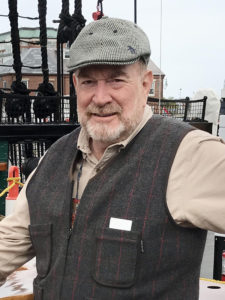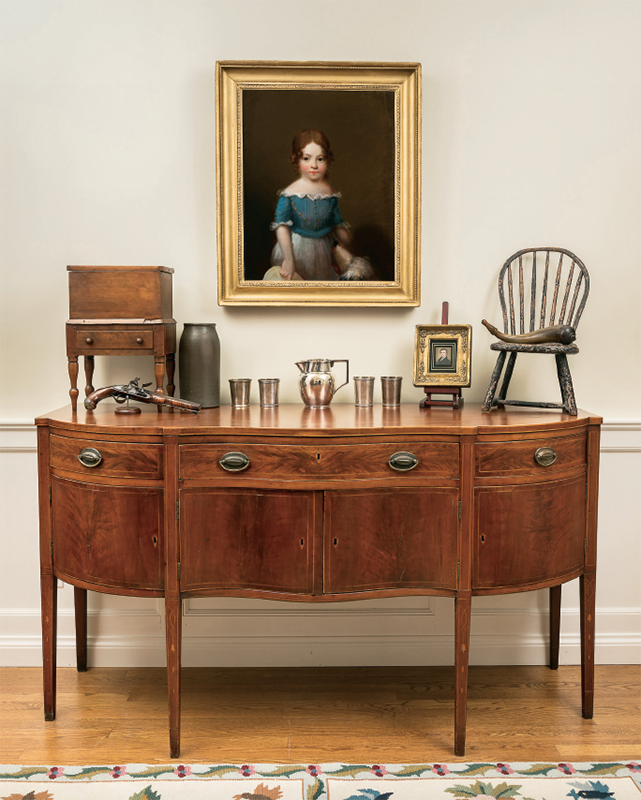Into the Bluegrass: Mel Hankla on the Art and Artistry of Kentucky’s Historic Icons
by Taryn Clary
 The stories presented within Mel Hankla’s book Into the Bluegrass: Art and Artistry of Kentucky’s Historic Icons are the product of more than 35 years of dedicated collecting, diligent research, and focused study. The book’s theme was sparked by the 2019 exhibition Into the Bluegrass: Rifles of the Kentucky Frontier presented jointly by the Kentucky Longrifle Foundation and the Kentucky Historical Society at Frankfort’s Thomas D. Clark Center for Kentucky History.
The stories presented within Mel Hankla’s book Into the Bluegrass: Art and Artistry of Kentucky’s Historic Icons are the product of more than 35 years of dedicated collecting, diligent research, and focused study. The book’s theme was sparked by the 2019 exhibition Into the Bluegrass: Rifles of the Kentucky Frontier presented jointly by the Kentucky Longrifle Foundation and the Kentucky Historical Society at Frankfort’s Thomas D. Clark Center for Kentucky History.
Into the Bluegrass: Art and Artistry of Kentucky’s Historic Icons tells a story that is both ancient and modern. From the earliest crossing of the Appalachians and Alleghenies by European settlers, to the contemporary and overdue recognition of African-American pioneer Jack Hart, the book takes the reader on a journey across a landscape that is not merely historical, but also contemporary.
In this interview, we learn about Mel Hankla’s journey to examine Kentucky’s material culture: that tapestry of utilitarian objects of everyday use, and objects of art or beauty created by a people for the satisfaction of their needs.
The Decorative Arts Trust: How did you begin your career in the decorative arts?
 Mel Hankla: I suppose this started in college when I learned of the National Endowment of the Arts Folkart Apprenticeship Grant. Using this knowledge, in 1983 I applied for and was awarded a $6,000 apprentice grant to work with Hershel Carmen House, a nationally known traditional flintlock riflesmith. I studied with Mr. House for three years. This experience spurred in-depth study of traditional American longrifles and brought about an awareness of the artistic ingredients within these iconic tools and associated accoutrements. This journey revealed common artistic association with many, if not most facets of frontier material culture.
Mel Hankla: I suppose this started in college when I learned of the National Endowment of the Arts Folkart Apprenticeship Grant. Using this knowledge, in 1983 I applied for and was awarded a $6,000 apprentice grant to work with Hershel Carmen House, a nationally known traditional flintlock riflesmith. I studied with Mr. House for three years. This experience spurred in-depth study of traditional American longrifles and brought about an awareness of the artistic ingredients within these iconic tools and associated accoutrements. This journey revealed common artistic association with many, if not most facets of frontier material culture.
DAT: Your book addresses what you consider a lag in academic scholarship in the field of Kentucky art history. When did you realize this was a topic you needed to write about?
MH: In many ways this was a by-product of producing a catalog for a longrifle exhibit that I curated at the Kentucky Historical Society. As I started recording the stories of each rifle I started to visualize a more complete tapestry of the cultural fabric.
DAT: The book features a range of objects, including portraiture, textiles, furniture, weapons, silver, and pottery. How did you define the scope of what types of material culture would be included and balance the diversity of material?
MH: The goal of this book was to illuminate the weave of the cultural fabric of the Bluegrass by examining the art and artistry of Kentucky’s historic icons. Among these icons, we find artistry in some unexpected places: in the craftsmanship of utilitarian items of everyday use. Other icons fall squarely within the realm of decorative arts. At the center of it all is the famed Kentucky rifle, examples of which are often accompanied by an array of related cultural artifacts that have been treasured by families and cherished by collectors over time. Objects like fine cabinetry or engraved silver or ornate longrifles do not become cultural icons solely on artistic merit, or because of their functionality on a frontier landscape. Objects become iconic by their dramatic impact on our culture: those objects crafted and made famous in the hands of our heroes. From those heroes come the stories, personal adventures, and harrowing experiences of settling this frontier Bluegrass Region. When a tool is imbued with the life of the artisan who crafted it, or the longhunter who carried it, only then can that tool transcend itself and become iconic, and therein provide the weave and color that gives our culture its texture.
The Frankfort sideboard dates to 1790. Primary wood is figured cherry with inlaid decoration with bell flower drops. Left to right: miniature sugar chest, flintlock pistol c. 1780, belonging to Colonel William Crabtree, stoneware by Isaac Thomas, coin silver pitcher by Asa Blanchard, coin silver beakers by Thomas Marsh and George McDannold, miniature on ivory by Matthew Harris Jouett, child’s Windsor chair from the estate of noted Kentucky Collector, Mrs. Eleanor Offutt, Kentucky powderhorn with applied antler tip from Robertson family. On the wall, “Nannie” by her uncle, Joseph Henry Bush.
DAT: What makes the Kentucky rifle so iconic?
MH: While the role of firearms is debated in modern society and culture, the Kentucky rifle is often overlooked as one of frontier America’s early art forms. Historically, the longrifle served as the weft of our cultural fabric, holding together the proverbial cloth and enabling a firm foundation upon which our American culture was built. Of the artistic items of material culture presented in this book, many would not exist if not for early settlers and artisans of the Bluegrass being protected and fed by this essential tool of survival. The longrifle itself would become an object of artistic expression with its many carvings, engravings, and brass and silver inlays. In his 1924 landmark book, The Kentucky Rifle, Captain John G.W. Dillion wrote that the longrifle “changed the whole course of world history, made possible the settlement of a continent, and ultimately freed our country of foreign domination.” Thus, early frontiersmen like Daniel Boone, Simon Kenton, and William Whitley carried this vital tool as they explored the interior of a young America. The men of Meriwether Lewis and William Clark’s famed Corps of Discovery expedition carried the longrifle to the far side of the continent. All these remarkable explorers built a firm foundation for the western expansion of America, upon which talented artists and skilled craftsmen have woven a colorful and sophisticated cultural tapestry that is the backdrop of our civilization.
DAT: What do you hope readers take away from the book?
MH: My goal was for the reader to see a panoramic overview that illuminates the relationships between the people of early Kentucky with the physical objects of their world: furniture, textiles, pottery, pictorial art, silver, firearms and their accoutrements. By understanding their practices of creating, using, and trading the objects that make up their material culture, and the social conventions, rituals, and stories that go with them, we come to an appreciation of the richness of our cultural heritage in the Bluegrass Region. The stories of iconic Kentucky men and women, and the artifacts that comprised their material culture had a deep and lasting impact on the region’s history, and contributed unique cultural footprints to an already long-inhabited land. The canvas of culture has been painted with traditions and styles that are anchored in the tight-knit communities that were often bound and concentrated by ridgelines and hollows that make up Kentucky’s geography. The styles incorporated the influences of the settler’s European cultural history, innovations particular to daily life on a frontier, and sometimes blended in stylistic elements from the aboriginal first peoples of Kentucky. These varied influences have contributed to an interwoven cultural fabric that is unique to the Bluegrass of Kentucky.
Learn more about and purchase Into the Bluegrass: Art and Artistry of Kentucky’s Historic Icons by Mel Hankla at intothebluegrass.net. Mel will lecture at the Decorative Arts Trust’s spring 2022 symposium Kentucky Bluegrass: From Lexington to Louisville, April 6-10, 2022. Sign up for alerts about upcoming Trust programs at www.decorativeartstrust.org.
Read more about decorative arts books by browsing The Bulletin of the Decorative Arts Trust, by signing up for the e-newsletter, and by following the Trust on Facebook and Instagram.
Taryn Clary is a contributing writer to The Bulletin of the Decorative Arts Trust.
About The Decorative Arts Trust Bulletin
Formerly known as the "blog,” the Bulletin features new research and scholarship, travelogues, book reviews, and museum and gallery exhibitions. The Bulletin complements The Magazine of the Decorative Arts Trust, our biannual members publication.










